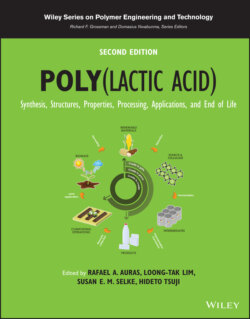Читать книгу Poly(lactic acid) - Группа авторов - Страница 84
3.4.3.3 Post‐Polymerization Treatments
ОглавлениеPost‐polymerization treatments for PLA prepared by ROP are strongly related to the processing and processability of the polymer. The processing of PLA is more demanding than that of commodity plastics due to the hygroscopic nature and the limited melt stability that can lead to hydrolytic degradation. The post‐polymerization treatments can mainly be divided into those performed in the melt as a finishing process or those done as a subsequent and independent processing step. Excluded from this review are post‐polymerization treatments involving simple polymer modification by the use of processing aids and other additives. The processes performed in the melt that are described in the literature are mainly focusing on improving the melt stability and the processability. Catalyst deactivation is one important feature that has been applied to PLA. Deactivators used include phosphorous‐containing compounds [179–181], nitrogen‐containing compounds [182], antioxidants [183], acrylic acid derivatives [184], and organic peroxides [185, 186]. The catalyst deactivation is generally performed in combination with a lactide removal process, which can be done by removing the low M w material at low pressures and at a temperature sufficiently high for distillation (devolatilization) [187, 188]. This process has been further developed by applying an inert gas flow in addition to the reduced pressure, which enables improved removal of the unreacted lactide [189]. The recovery of lactide has also been integrated in the polymerization process of new PLA as a means for improving the efficiency in the manufacturing chain [190]. Another way for reducing the lactide content of PLA is to apply solid‐state polymerization of the residual lactide containing PLA below its T m, which besides reducing the residual lactide content also increases the molecular weight of the polymer [191].
Separate post‐polymerization treatments of PLA have also been described in the literature. Drying of the polymer is generally done before processing to minimize the thermohydrolysis and molecular weight reduction during the melt processing. Suggested drying conditions for crystallized PLA is in the temperature range of 65–90°C, using dehumidified air with a dew point of −40°C [192]. More recently, the end‐of‐life options of bio‐based polymers have been brought into sustainability discussions. For PLA, this can be seen in the form of a number of suggested approaches on how to deal with waste materials from the polymerization process, the manufacturing process of end products, or the end product after its use. Converting of PLA into lower‐molecular‐weight polymers has been described, as well as the complete hydrolysis of the polymer into LA for use as new building blocks for either biosolvents or polymers [193–195].
